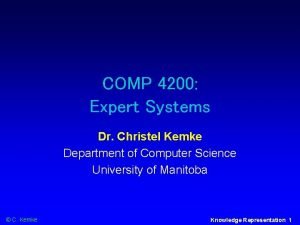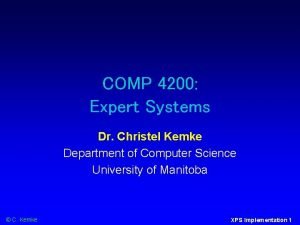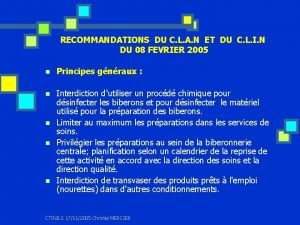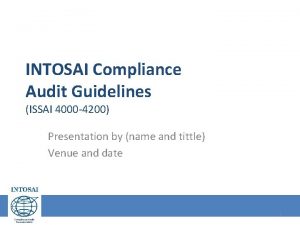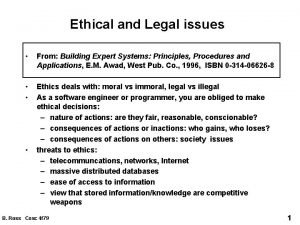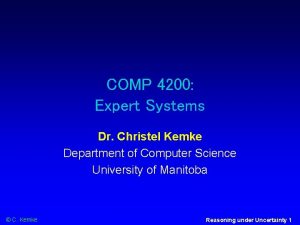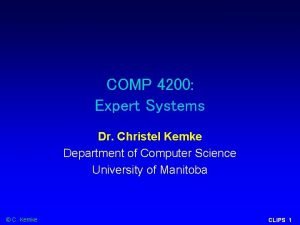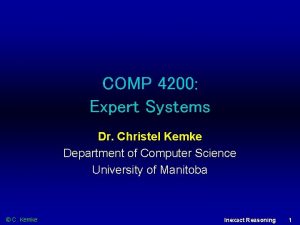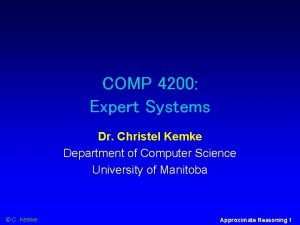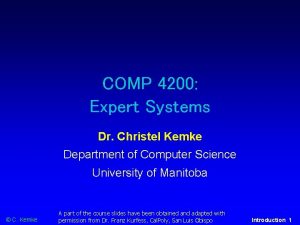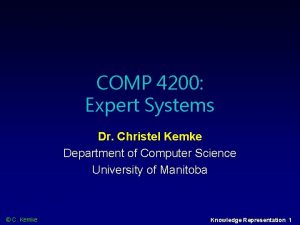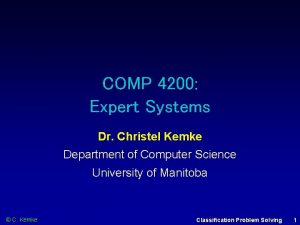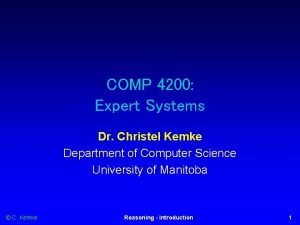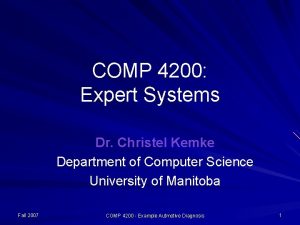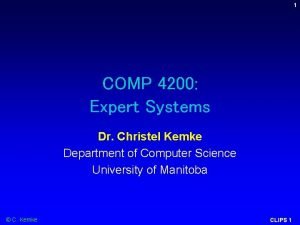COMP 4200 Expert Systems Dr Christel Kemke Department














- Slides: 14

COMP 4200: Expert Systems Dr. Christel Kemke Department of Computer Science University of Manitoba © C. Kemke Expert Systems Tasks 1

Expert Systems Task Areas cf. Jackson, Ch. 11 'Heuristic Classification I‘, based on Clancey (1993), Hayes-Roth et al. (1983), Waterman (1986); for exact references see bibliography in Jackson © C. Kemke Expert Systems Tasks 2

Task Areas of XPS Ø Tasks /Task Areas of Expert Systems What kinds or types of tasks do XPS perform? e. g. diagnosis, construction Ø Classification of XPS Task Types How can XPS be analyzed into different tasks or categories of tasks? - analysis vs. synthesis © C. Kemke Expert Systems Tasks 3

Classification of XPS Tasks Generic Tasks in Expert Systems (XPS) § Analysis analytical view and treatment of domain or system behaviour; e. g. diagnostic problems § Synthesis constructive problem solving or constructive approach to generate system (behaviour); e. g. construction problems (Clancey (1985), see Jackson, p. 209 ff. ) © C. Kemke Expert Systems Tasks 4

Task Areas of Expert Systems System-Based View of XPS Tasks Analysis Tasks (Interpretation of System) Diagnosis Classification Synthesis Tasks (Construction of System) Construction Configuration Design Planning © C. Kemke Expert Systems Tasks 5

Analysis Tasks (Diagnosis, Classification) determine specific solution element (diagnosis) based on a description of the system (symptoms or other descriptive facts) rules formulate connections between symptoms etc. and diagnostic class e. g. the medical expert system MYCIN for diagnosing bacterial infections e. g. tutoring systems like GUIDEON for diagnosing student’s mistakes © C. Kemke Expert Systems Tasks 6

System Analysis Operations INTERPRET IDENTIFY MONITOR © C. Kemke PREDICT CONTROL DIAGNOSE Expert Systems Tasks 7

Analysis Tasks INTERPRET analyze and interpret system (input, output, structure) IDENTIFY given input-output pairs, determine kind of system PREDICT predicting output for class of given inputs CONTROL determine inputs which achieve specific state/output MONITOR detect discrepant (faulty) behaviour DIAGNOSE explain (faulty) behaviour © C. Kemke Expert Systems Tasks 8

Synthesis Tasks (Construction, Configuration, Design, Planning) © C. Kemke combine elements from a component (solution) space and check consistency of complete solution rules formulate constraints and extensions for partial solution, similar to planning e. g. the technical expert system R 1/XCON to configure computer systems Expert Systems Tasks 9

System Synthesis Operations CONSTRUCT SPECIFY DESIGN CONFIGURE © C. Kemke ASSEMBLE PLAN Expert Systems Tasks 10

Expert Systems Synthesis Tasks CONSTRUCT Solution space is not pre-defined SPECIFY state constraints for any solution DESIGN generate arrangement of parts to satisfy constraints ASSEMBLE / MODIFY realize design by putting parts together CONFIGURE (Design) layout of design PLAN (Design) methods to assemble structure © C. Kemke Expert Systems Tasks 11

Expert Systems – Tasks Interpretation Prediction Diagnosis Control Monitoring Planning Design Debugging and Repair Instruction ANALYSIS SYNTHESIS (Hayes-Roth et al. (1983), see Jackson, p. 208) © C. Kemke Expert Systems Tasks 12

Expert Systems – Tasks 1 Interpretation forming high-level conclusions from raw data Prediction projecting probable consequences of given situations Diagnosis determining the cause of malfunctions in complex situations based on observable symptoms Design finding a configuration of system components that meets performance goals while satisfying a set of design constraints © C. Kemke Expert Systems Tasks 13

Expert Systems – Tasks 2 Planning devising a sequence of actions that will achieve a set of goals given certain starting conditions and run-time constraints Monitoring comparing a system’s observed behavior to its expected behavior Debugging and Repair prescribing and implementing remedies for malfunctions Instruction detecting and correcting deficiencies in students’ understanding of a subject domain Control governing the behavior of a complex environment © C. Kemke Expert Systems Tasks 14
